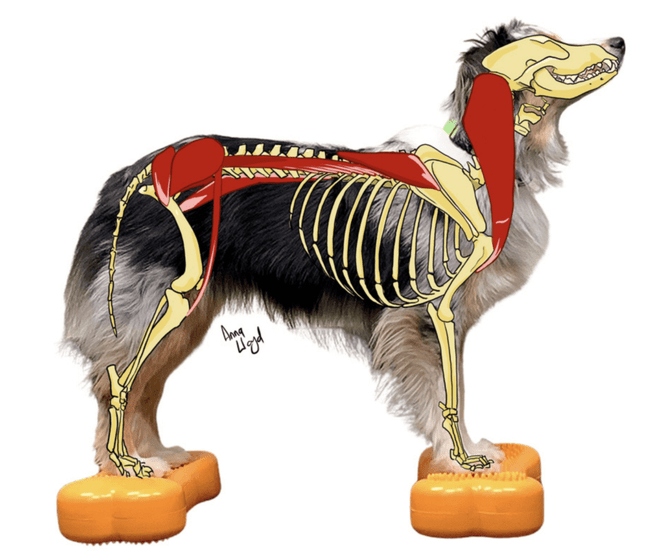Canine hip dysplasia is a common and progressive orthopedic condition affecting the development and function of the hip joint, primarily in large-breed dogs. It is characterised by joint laxity in young animals and, due to abnormal joint wear, progresses over time to osteoarthritis. While the condition can be painful and debilitating, early intervention and a multimodal treatment plan can significantly improve a dog's comfort and mobility.
What Causes Hip Dysplasia in Dogs?
Canine hip dysplasia arises from a combination of genetic and environmental factors, generally with a strong hereditary influence. Although large-breed dogs such as Labradors, German Shepherds, and Golden Retrievers are most commonly affected, small breeds, however, are not immune to the problem.
The condition begins during a puppy’s growth phase when the ball and socket of the hip joint do not fit snugly. This leads to joint laxity and instability, which triggers abnormal movement patterns that may damage cartilage and surrounding soft tissues. Over time, the body attempts to stabilise the joint, which leads to degenerative changes and the development of osteoarthritis.
Factors that influence the development and severity of hip dysplasia include:
Excess weight: Overweight dogs place more stress on developing joints, increasing the risk and severity of canine hip dysplasia (Kealy et al, 1992)
Over-exercise during growth: Puppies exposed to high-impact activities, such as repetitive jumping or rough play, may be susceptible to joint wear
Poor nutrition: Imbalanced diet (especially those with inappropriate calcium-phosphorus ratios) can affect skeletal development
Slippery flooring: Tiled and polished wood surfaces provide poor traction, which may inhibit healthy muscle development and joint stability in growing dogs (Zink and Van Dyke, 2013)
Musculoskeletal Effects of Hip Dysplasia
Dogs with canine hip dysplasia often develop compensatory musculoskeletal changes. Surrounding muscles must work harder to support the body owing to instability and discomfort in the hip joints.
This often results in:
Overuse and tightness of muscles, especially iliopsoas, hamstrings, and hip adductors.
Atrophy of underused stabilising muscles.
Postural adjustments, including a tucked pelvis or roached back.
Shifting weight forward to the forelimbs, predisposing the shoulders and elbows to strain.
Common compensatory gait patterns include bunny hopping, a swaying gait, or stiffness upon rising or lying down. Left untreated, these patterns can lead to secondary injuries and pain.
Diagnosing Canine Hip Dysplasia
Diagnosis involves a comprehensive evaluation, including:
Clinical history; Analysis of gait and posture.
Manual palpation and range-of-motion tests.
Orthopedic tests such as the Ortolani or Barlow test to assess joint laxity.
Radiographs (x-rays) to confirm joint incongruity or degenerative changes.
Early diagnosis, particularly in predisposed breeds, allows for more effective management and prevention of severe osteoarthritis later in life.
Treatment and Management Options
Treatment of hip dysplasia varies depending on the dog's age, severity of disease, and overall health. Management falls into two broad categories:
1. Conservative (Non-surgical) Management
Conservative treatment is the first-line approach for many dogs and can significantly improve quality of life when implemented early. It includes:
Weight management to reduce joint strain.
Physiotherapy and rehabilitation to strengthen supportive muscles and correct imbalances.
Hydrotherapy, such as underwater treadmill or swimming, to encourage low-impact movement.
Pain relief, including anti-inflammatories, joint supplements (i.e. omega-3 fatty acids), laser, acupuncture, and other soft-tissue therapies.
Environmental modifications, such as avoiding slippery floors or stairs.
2. Surgical Management
Surgery may be considered in dogs with severe pain or when conservative methods are no longer effective. Options include:
Juvenile corrective procedures (for puppies under 6 months):
Juvenile pubic symphysiodesis
Triple pelvic osteotomy
Salvage procedures (for severe osteoarthritis):
Femoral head and neck excision
Total hip replacement
A veterinary surgeon will determine the most appropriate option based on radiographic and physical examination findings.
Rehabilitation for Hip Dysplasia
A structured physiotherapy programme aims to maintain mobility, minimise pain, and slow disease progression. Key components include:
Targeted strengthening of gluteals, core, and stabilising muscles
Proprioception and balance work to improve joint awareness
Manual therapy, including massage and stretching
Hydrotherapy for controlled exercise in a low-weight environment
Gait re-education and Postural correction to address compensation patterns
Owner education and a personalised home-care plan
Rehabilitation addresses the affected hip joint and prevents secondary compensatory issues.
Conclusion
Canine hip dysplasia is a complex condition that can seriously undermine a dog’s quality of life. However, early diagnosis and a proactive management plan involving veterinary care, physiotherapy, and lifestyle modifications, dogs with canine hip dysplasia can live active, comfortable lives. Dog owners play a crucial role in observing early signs, maintaining a lean bodyweight, and adhering to physiotherapy rehabilitation plans.
References
Kealy, R.D., Lawler, D.F., Ballam, J.M., et al. (1992). Evaluation of the effects of limited food consumption on radiographic evidence of hip joint osteoarthritis in dogs. Journal of the American Veterinary Medical Association, 201(6), 857–863.
Lotsikas, P.J., Canapp, S.O., Dyce, J., Kirkby, K., Christopher, S., and Ridge, P.A. (2013) ‘Disorders of the Pelvic Limb: Diagnosis and Treatment’. In: Zink, M.C., and Van Dyke, J.B. (eds.) Canine Sports Medicine and Rehabilitation. Iowa: Wiley-Blackwell, pp. 267 - 295.
University of Pennsylvania Hip Improvement Program (PennHIP). Available at: https://antechimagingservices.com/antechweb/pennhip
Vasseur, P.B. (1992). Clinical results following juvenile pubic symphysiodesis. Veterinary Surgery, 21(5), 367–373.
Zink, M.C., & Van Dyke, J.B. (2013). Canine Sports Medicine and Rehabilitation. Wiley-Blackwell.



